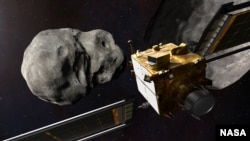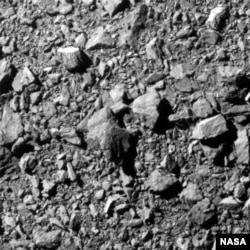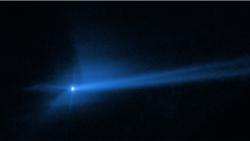Several new studies confirm the success of a test by the American space agency NASA to crash a spacecraft into an asteroid.
The studies suggest the experiment was an important first step in learning how spacecraft might be able to protect Earth from asteroids or other space objects that might threaten the planet.
NASA carried out the operation last September with the DART spacecraft. It crashed into an asteroid called Dimorphos, a small “moonlet” that orbits a larger asteroid, Didymos. The crash happened about 11 million kilometers from Earth.
NASA reported in October that it considered the test a success because the force of the crash changed the path of the asteroid. Now, several new studies are confirming the effectiveness of the experiment.
A team from the Johns Hopkins Applied Physics Laboratory in Laurel, Maryland examined data about the mission that NASA describes as the world’s first planetary defense test. But the asteroid targeted in the mission never presented a threat to Earth.
Satellites and powerful telescopes observed DART’s crash into the asteroid. The goal of the crash was to see how it might redirect the asteroid’s path and speed.
Before the hit, Dimorphos was completing one orbit around Didymos every 11 hours and 55 minutes. The latest results showed the crash reduced this orbital period by 33 minutes. This is one minute more than NASA first announced after examining data from the crash in October.
"The DART test was phenomenally successful,” said planetary scientist Terik Daly of the Johns Hopkins University Applied Physics Laboratory. He added that the experiment proved the impact method could be used to prevent an asteroid from crashing into Earth “if one day we had the need to."
The studies, which recently appeared in the publication Nature, examined many different elements involved in the crash experiment. These included a major study of the impact itself and looking closely at crash timelines and investigating how the targeted asteroid changed size and shape.
The researchers said one of the most important findings was that the asteroid’s travel path was not just affected by being struck by the DART spacecraft. The space object’s speed and direction were also greatly influenced by materials released by the asteroid after impact.
The researchers said the impact by the DART spacecraft led to a recoiling effect of the asteroid. When something recoils, it moves suddenly in reaction to a force. A large amount of material from the asteroid was observed after impact, the team reported.
This recoiling effect – caused by materials being released into space after the crash – gave the object additional momentum, the team reported. The researchers reported the impact caused an immediate slowing in the targeted asteroid’s speed. The additional momentum Dimorphos picked up from the release of materials was far greater than the spacecraft impact itself, they added.
The researchers noted the experiment showed that such operations can be carried out on asteroids that have not been studied in-depth before. What is required, however, is enough warning time to prepare for a specific mission. The team said that ideally, scientists will need several years of lead time to study any asteroids identified as a threat to Earth.
The scientists noted DART’s impact had turned Dimorphos into an “active asteroid.” An active asteroid is one that orbits like other asteroids, but has a trail of material following it, like a comet.
Some scientists had in the past proposed the idea that some active asteroids are the result of impact events. But until the DART experiment, no one had observed an actual activation.
Daly, of the Applied Physics Laboratory, said no known asteroids currently present a threat to Earth. But he added that the latest studies support the need for more research to prepare for such a possibility. Daly made a comparison to testing a car's airbags. “You make sure they work during a crash test instead of waiting to get in a real car accident to find out if they work," he said.
I’m Bryan Lynn.
Reuters, NASA and Nature reported on this story. Bryan Lynn adapted the reports for VOA Learning English.
_______________________________________________________________
Words in This Story
asteroid – n. a rocky object that goes around the sun like a planet
mission – n. a flight by an aircraft or spacecraft to perform a specific task
phenomenal – adj. extremely successful or showing great qualities or abilities
momentum – n. the way in which something continues to move, increase or develop
trail – n. a line of marks that someone or something leaves behind as they move
comet – n. an object in space that leaves a bright line behind it in the sky
__________________________________________________________________
What do you think of this story? We want to hear from you. We have a new comment system. Here is how it works:
- Write your comment in the box.
- Under the box, you can see four images for social media accounts. They are for Disqus, Facebook, Twitter and Google.
- Click on one image and a box appears. Enter the login for your social media account. Or you may create one on the Disqus system. It is the blue circle with “D” on it. It is free.
Each time you return to comment on the Learning English site, you can use your account and see your comments and replies to them. Our comment policy is here.













Forum